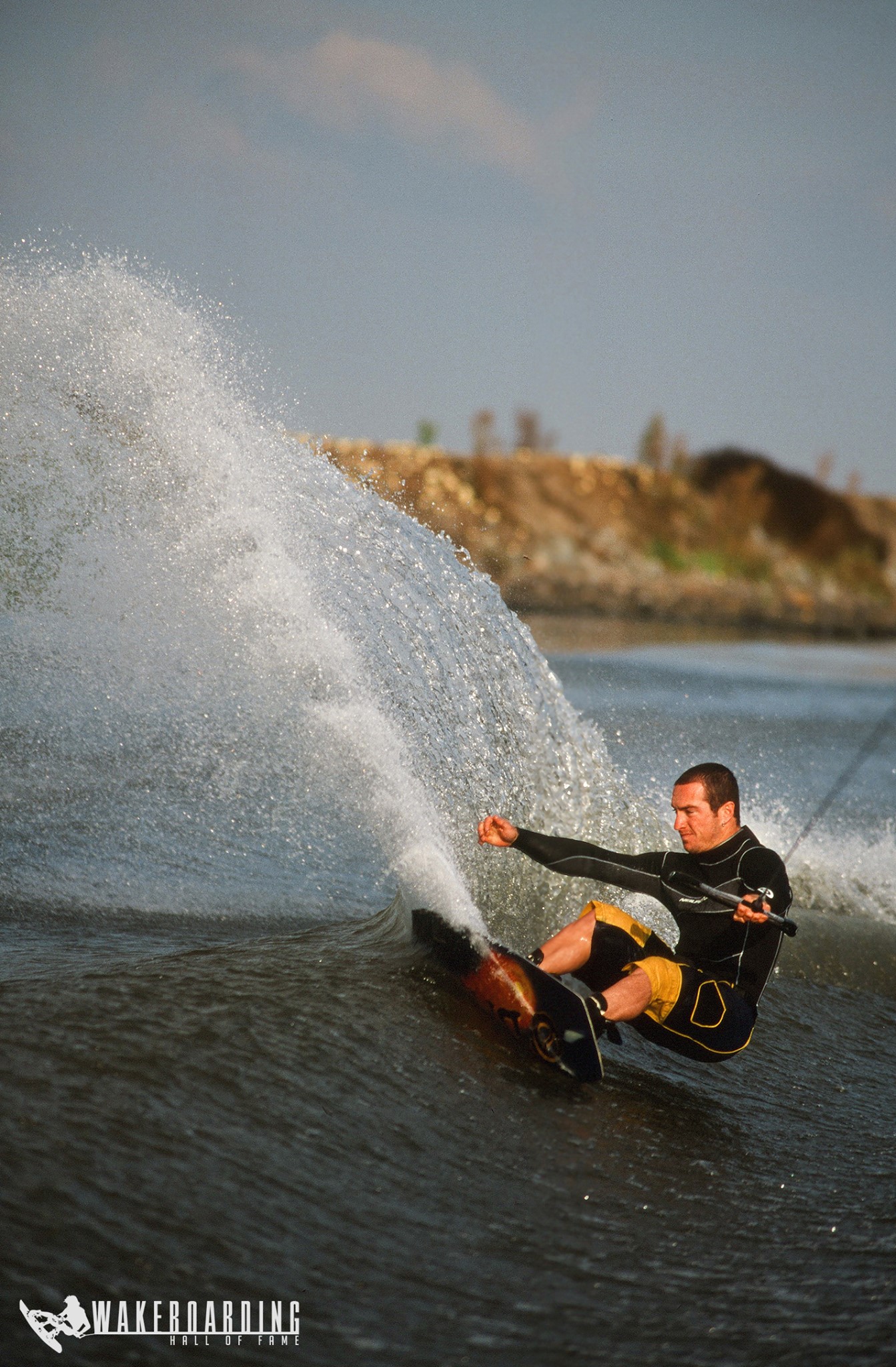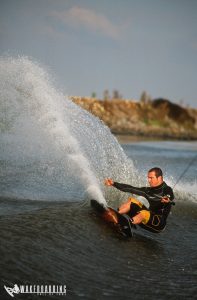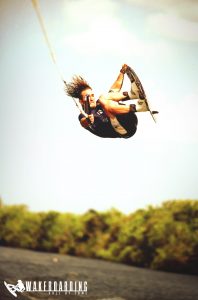
19 May FULL CIRCLE – An Interview with Darin Shapiro (Part 2)
WHF: You’ve credited Chet Raley and Mike Ferraro as being instrumental coaches in your career. What was it that made your relationship with them so special and why do you think you were able to be so successful together?
DS: Number one, Mike always kept it fun. More than anything, it never felt like training and coaching. It felt like a relationship where you ultimately trusted someone so much because they continued to pull things out of you that you never expected to do. On top of that, if we came up with an idea for something new, or the next progression of something and you watch these things work over and over, then there’s no question. The only question is how far can you continue to take it? And that is fun. Like I said, it was always fun! And when things are working, everyone’s smiling.
WHF: Did you ever get into any arguments? If so, what did you argue about?

2002 (Photo Kelly Kingman)
DS: No, I would just say he would tell me, “You got to do the Speedball. Or you got to do, you know, whatever it is.” I would just so believe in his word, that it would surpass any doubts that I had. I’d so believed what he said, and ninety nine out of hundred times, the man was right. So when it keeps working like that, you don’t mess with it.
WHF: Let’s switch gears again. When it came to competitions, did you design your runs differently depending on if you were first, middle or last off the dock?
DS: Absolutely! I had a plan A, B and C, every contest. There was at least a plan A and B, but what if it was blown out? What if it was rolly? This was before Perfect Pass, so what if the driver was all over the place in the preliminary rounds? I had a plan. I had a plan. I had a plan.
WHF: Would you play it safe if you were last off the dock and knew you didn’t have to throw your hardest run to win?
DS: Yep! (laughing). I wouldn’t say I was always proud of my strategy but you have to be smart. When it came to wakeboarding in my heyday, I was not a gambling man. I had a good game, a good strategy, and I got to the point that I didn’t care what my peers thought about my run. I cared about how it stacked up against what was going on that day, at that lake, behind that boat.
WHF: It’s no secret that your legacy in wake is about going big. Both in the past and present, you’ve talked about the judging formats not giving that area enough value.
In your opinion, what were the flaws in the judging system back then, and do you see any issues today that still need to be addressed?
DS: There were never really flaws with the judging system as much as there were people’s different views of how they wanted to see the sport. Those are never going to be very consistent across the board if you have people who are their own independent person. The last thing you want is a group of judges who all feel the same way about wakeboarding. I feel like there were a few years here and there where you had a group of judges who all kind of felt the same way, and I think that can really take away from the individuality of each rider. There are always going to be bias, but sometimes it’s to the detriment to the sport.
WHF: If you were charged with creating the most objective but optimal format, what would it be?
DS: I’ve never claimed to be a judge. Of course I’ve always had an opinion (lots of laughing). The judges have a very difficult job. If I were going to be a judge, I feel like there’s a set group of tricks that each rider has to hit to be in contention of making it through the rounds or getting on the podium. Unfortunately, even at the highest level, there’s still a lot of similarity between the runs. I really appreciate individuality, watching each rider bring something new and different to the table. If not, it looks like no one’s really thinking outside the box. A lot of the runs today look the same. I’m not saying the tricks aren’t amazing. But to keep it exciting for the people watching, each rider should have individuality.
WHF: What would go through your mind in the few days, hours, minutes leading up to your competition run?
DS: I always played the odds of how I was riding leading up to an event as a part of my strategy. If I’m not 80% or higher on a trick, it may not end up in my run that week. I was always just playing the odds, as I would train leading into the event. Because consistency is key when you’re on Tour, at a World Cup, or something where all the points are accumulative and that overall title is a factor. So, I would pinpoint on how I would attack that event. I already knew, three or four days before, what my A and B plans were. Additionally, I was the kind of guy where it kept me up at night a little bit because I wanted the best plan. I was eating, sleeping and breathing the contest.
WHF: What would you do if you got to a new contest site where you’ve never been before and the conditions didn’t suit your A, B and C plans. Would you just improvise?
DS: I would watch guys before me go out, and if there were something really funky going on, like everybody was falling, then I would adjust. I’d back way off. If everybody was going out before me and killing it, I’d notch up because if you’re
seeing consistently good performances, there’s a reason. If you’re seeing consistently bad performances, there’s a reason.

HS Slob Front to Fakie 1997 (Photo Kelly Kingman)
WHF: Was there ever a time you doubted yourself standing on the dock right before you were ready to ride?
DS: All the time. The problem with being the top seed often, or the points-leader, it’s more pressure than just showing up at a random event and seeing how it goes. Often I was looking for trouble spots or what could go wrong. I had a plan for everything to go right but where could a trouble spot be? I would always fall back to good training. I have a key for this and I have a key for that. I always just trusted it, trusted myself, not let it bother me and just ride through it. But sure there were moments of, “uh oh, maybe I shouldn’t do that trick now.” But another part of me would remember that I’m trained to go out and accomplish this right here and now, and I would just have to trust myself.
WHF: Did you ever feel like you choked in a contest?
DS: I don’t think so. I think when you ride that many contests you’re bound to make a mistake, miss the handle, or should’ve put a trick in your run that you didn’t put in. But I always felt like the excitement or the rush of going into the contest was something that always helped me. It was like fight or flight, and I was there to fight. I think that’s one thing I learned about myself over the years. No matter how shaky I started to feel, I hit the water and it might as well have been at home. I could shut everything off and whatever nerves I had, the rope gets tight and I’m just wakeboarding.
WHF: Was there ever a time when a rider surprised you with their run, right before your run, and put some doubt in your head as to whether or not you could beat him?
DS: Have you ever seen Danny Harf ride??? (lots of laughing). Yeah, I’d have a full- on plan, all set up. A guy like Danny Harf straps on his boots. You do your run and you’re like, “oh yeah that should do it, that should do it.” You start wiping your hands off, and then you watch Danny go up and down the lake. And you go, “I guess I’ll pack my stuff up now” (more laughing). So yeah! Of course! Later in my career, there were some really amazing athletes popping up and just doing some great things. I was sticking to my consistent game because that was my game, and there were flashes of all kinds of really fantastic runs. The guys had a different strategy. They were swinging for the fences and busting out huge runs. They may not have made it every time but when they did, it was a sight to see.
WHF: It was said that you and Mike Ferraro would talk before your run, and even walk the course? What would you discuss?
DS: I think the type of way we communicated over the years, taught me to walk down to the turn-around on each end. Then I’d look at the water and I’d look at the course from the very end. The visualization is so important. You can’t just get to an event, peek at the water, get dressed, put your board on, hop on the dock and go. And then have everything be brand new. I felt like a part of my preparation was to get a very good look at everything. I’d take a look at the wake, if I could. Watch the boat and visualize as much as I could about what was going on with all the setups. How much time do you have before the first rail? How much space is between each rail? Where’s the double up and how are they setting that up? Is it messing up the water for when I get off the dock? So I had a little checklist and after a while it just became very normal for me. It was just my routine.
WHF: Out of all the tricks you’ve invented, of which one are you most proud?
DS: That has really changed over the years. It was always whatever was new. I guess overall, it would be the Speedball only because it was the first double flip in the history of our sport, or waterskiing of any kind. So that was a major accomplishment for me. It was before Skylons, on a low pole and it was when we first started figuring out how to even drive the boat for double ups. And I think it was less than ten tries. It was when I was coming back from my injury and nothing was going to stop me. Also when it comes to actual tricks, I think one of my biggest accomplishments was being able to continually stay progressive. Having watched a lot of riders come and go, staying progressive and invent new tricks even though they kind of got older was key. That really just meant a lot to me as to what kind of vision I had for things that could be done on a wakeboard and the discipline to accomplish those things.
WHF: Is there a trick that you never could land, minus the triple front flip?
DS: Hmmm. I can’t really think of much. I did try double half cab rolls for a little while. I did just a couple, got smoked a bunch and left it alone. That would’ve been a cool one. I think that’s a great trick.

2016 Inductee’s of The Wakeboarding Hall of Fame (Photo Matt Maloy)
WHF: Which trick is still the most fun for you?
DS: That’s always different for me because I can do a flat line 180 and if I get booted, I’ll hold the grab long and land butter on the transition. That’s a really unique-feeling trick. I would really like to see more riders try that stuff because you don’t see it often. It doesn’t have to be something huge but it’s got to feel unique, a different type of movement. That reminds me more of almost like a hand plant on a half pipe. The way you rock over the rope and it’s a feeling I don’t get from anything else. On the other hand, at the risk of sounding gay, with today’s wakes, landing a really huge Raley where you get two or three pulls from the boat is also fun. It feels like you swing, then you swing and then you swing some more. The pure physics of it, for me, it’s a cool thing. I mean who doesn’t want to stay in the air as long as they can, right? When you’re so high that you’re looking down on the boat, I don’t care, gay or not, the feeling’s there. The speed that I generate to the wake, the boot I get, hanging up there, I like the way it feels.
(Header photo: Tanya Pavlis)



Sorry, the comment form is closed at this time.